They say that you need to capture the “voice of the customer” to grow your business. But what exactly do they mean by “voice of the customer”, and how do you capture it effectively?
Don’t feel bad if you’re unsure — I’m here to help.
The “voice of the customer” refers to user feedback. Once you learn to collect it, you’ll be able to properly evaluate customer satisfaction and improve your product or service.
In this article, I’ll introduce you to nine types of user feedback, how to collect user feedback the right way, challenges you might face when analyzing user feedback, and more.
Let’s get to it!
Types of User Feedback
Before you collect feedback for your company, you should know the different kinds available. This knowledge will keep you focused on the types of user feedback that will further your goals.
User feedback can be separated into three broad categories: direct feedback, indirect feedback, and inferred feedback. Let’s take a closer look at each one…

Direct Feedback
The term “direct feedback” refers to user feedback that you solicit.
There are plenty of ways to collect direct feedback from your target audience. For example, you can send a variety of surveys to customers, host interviews, and/or run user testing campaigns:
-
- Surveys: When it comes to user feedback collection, you can’t go wrong with surveys.A net promoter score (NPS) survey will help you measure customer loyalty and enthusiasm. A customer satisfaction score (CSAT) survey will help you track customer satisfaction levels. And a customer effort score (CES) survey will give you data to improve your website’s or app’s user experience.
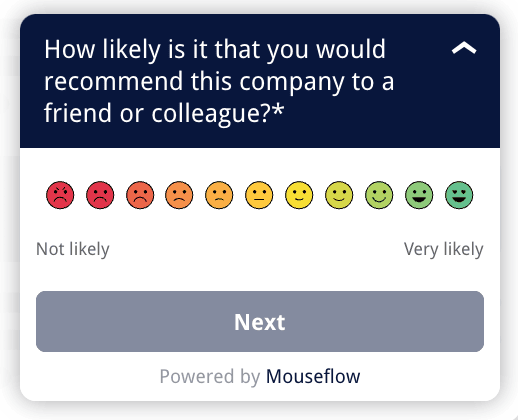
An example of an NPS survey created with Mouseflow
Of course, not every feedback survey revolves around scores. You can also use surveys to ask open-ended questions and receive qualitative feedback. To do this, you’ll need a user feedback tool like Mouseflow.
We’ll talk more about user feedback tools in just a few minutes — stay tuned. At the end of the day, surveys are an easy way to collect direct feedback, but they won’t always give you the deep customer insights that interviews will. Speaking of which…
- Interviews: Surveys aren’t the only way to gather direct feedback. You can also interview your customers — either in one-on-one scenarios or by building focus groups. Both methods take time and effort to set up. But the in-depth, quality feedback they produce will tell you a lot about your customers and the specific pain points they have.
- Surveys: When it comes to user feedback collection, you can’t go wrong with surveys.A net promoter score (NPS) survey will help you measure customer loyalty and enthusiasm. A customer satisfaction score (CSAT) survey will help you track customer satisfaction levels. And a customer effort score (CES) survey will give you data to improve your website’s or app’s user experience.
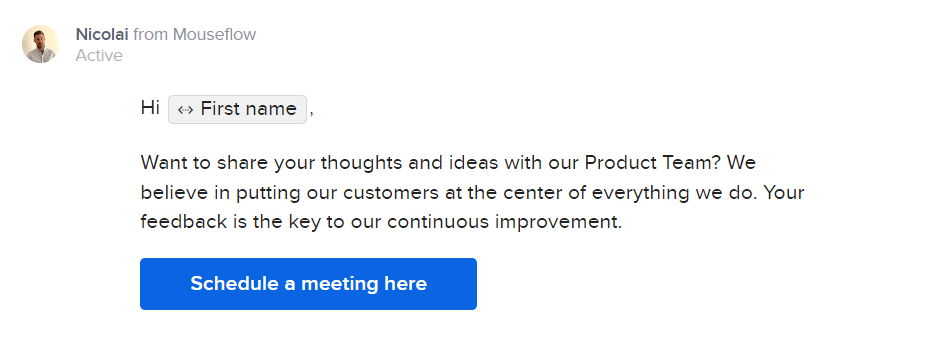
We regularly invite our customers to interviews so that we can learn first hand how we can make Mouseflow better for them.
- User testing: What if you asked customers to test a new offering before it’s released, then provide feedback on their experience? It would probably lead to new developments, right?User testing will allow your company to see how its new product or service is received by its target audience in a low-risk situation. Unfortunately, user testing is often expensive and time-consuming. But in the right situations, the insights user testing offers are more than worth the cost and effort expended.
Indirect Feedback
The term “indirect feedback” refers to user feedback that you do not solicit. Instead, this form of feedback comes to you via social media, online review sites, and similar means:
-
- Social media: Your company’s Facebook, Instagram, and/or TikTok profiles can be used to collect user feedback. How so? By using a technique called social listening.Use tools that can pick up every conversation that mentions your brand on social media platforms, then use the data you collect to evaluate customer satisfaction, learn about their pain points, and even gauge customer loyalty.
Or make things easier on yourself and invest in a social listening tool with sentiment analysis capabilities. This kind of technology will assess customer content to find deeper meanings, helping users easily filter through the noise.
Did I say we’ll get to the tools in a moment? We’re almost there. But there are a few other feedback types to discuss.
- Online reviews: Platforms like Google, Yelp, G2, and Amazon are incredible resources — both for people who want to buy new products and services and for companies that want customer feedback.Encourage your target audience to leave reviews on these sites. You can even incentivize them with gift cards, discount coupons, etc., to increase the number of reviews you receive. Then read through the feedback to learn about your customers, what they like and dislike.
💡Pro tip: I suggest reading competitor reviews as well, to understand how your offerings compare and do some market research.
- Social media: Your company’s Facebook, Instagram, and/or TikTok profiles can be used to collect user feedback. How so? By using a technique called social listening.Use tools that can pick up every conversation that mentions your brand on social media platforms, then use the data you collect to evaluate customer satisfaction, learn about their pain points, and even gauge customer loyalty.
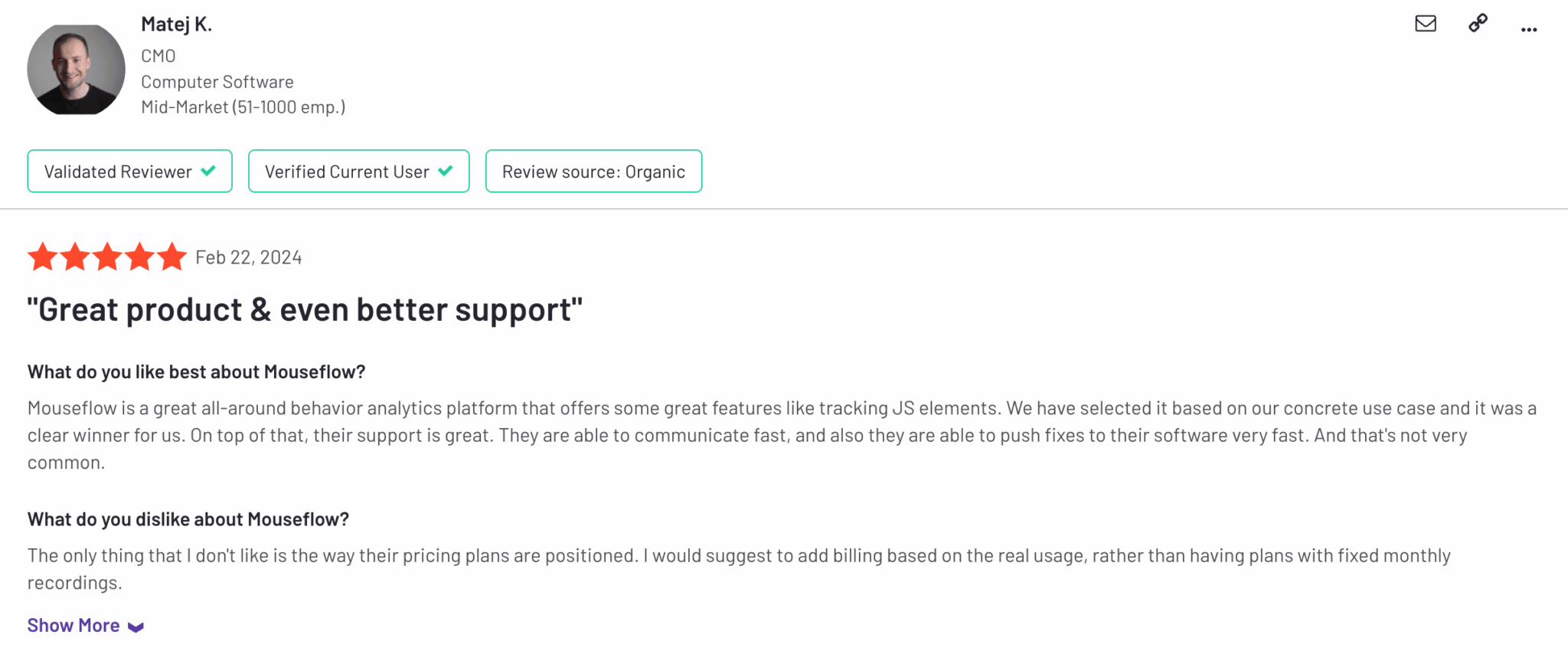
We keep an eye on our G2 reviews and process all reviews to ensure we meet our customers’ expectations
- Customer support interactions: When’s the last time you talked to your company’s customer support team? These folks collect feedback on a regular basis by fielding complaints, questions, and feature requests. As such, they represent valuable feedback opportunities.Use the information they have to your advantage by updating your product or service based on consistent customer opinions.
Inferred Feedback
The term “inferred feedback” refers to specific data points that can be used to evaluate customer experiences.
This type of user feedback is different from the ones we’ve already covered. Why? Because your customers won’t actually tell you what they think. You’ll need to analyze their behavior to measure customer satisfaction and determine how to improve your website.
Here are three ways to gather this kind of customer feedback for your organization:
- Heatmaps: Website heatmaps monitor the way users interact with webpages. Then they display the information collected in a visual way that allows for easy understanding.
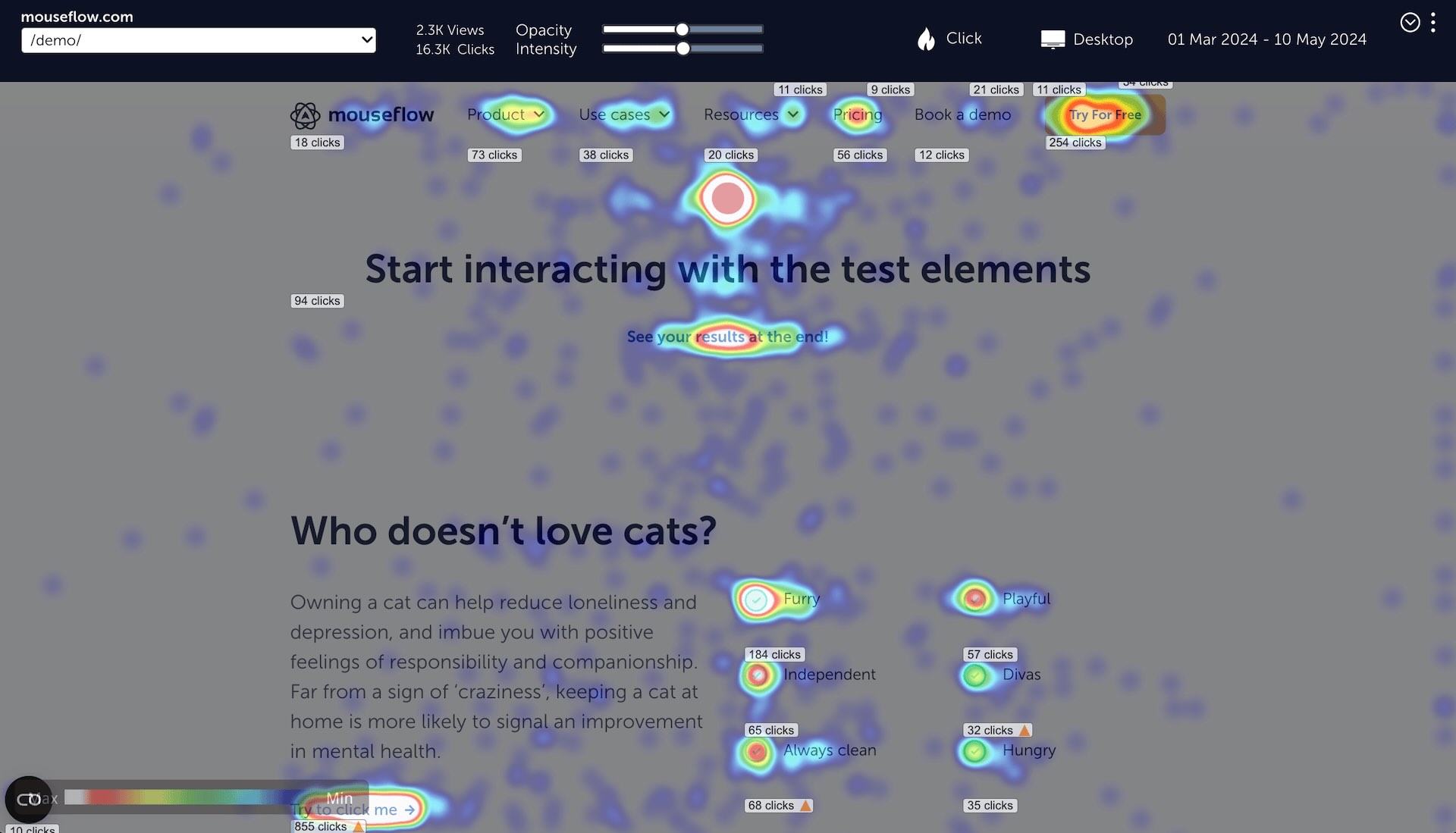
An example of a click heatmap
Once you start using heatmaps on your company’s website, you’ll be able to tell where users click, how far they scroll, and what engages their attention. You can then use this information to craft better webpages.
- Session recordings: What if you could physically see the way customers interact with your company’s website? Oh wait, you can. Session recording tools will anonymously record website users, then allow you to watch the replays at a future date.This will help you determine what users like about your website, how they behave while navigating it, the patterns they exhibit while trying to accomplish specific tasks, and more.
- Usage histories and patterns: The data that session replay and heatmap tools collect will provide you with additional user insights. For example, information like scroll depth and time on page – or, even better, time that people are engaged with the page – will help you identify patterns.When you know how your audience uses your website, you can adjust it to achieve better results.
The techniques above represent a unique form of user feedback collection. By studying customer behavior, you can learn a lot about their preferences and pain points. Armed with this data, you’ll be able to make necessary changes that lead to happier users.
Proactive vs. Reactive User Feedback Collection
You might hear the terms “proactive user feedback” and “reactive user feedback” as you research this topic. Then you might think, “What the heck do those terms mean?”
Proactive user feedback is another way to say “direct feedback”. It’s the kind of feedback you solicit via surveys, interviews, and user testing campaigns.
Reactive user feedback is another way to say “indirect feedback”. It’s the kind of feedback you do not solicit, and you get it from social media and online reviews.
Does that make sense? Good, now let’s talk about how to collect customer feedback.
How to Collect User Feedback the Right Way
Knowing the different types of user feedback is one thing, collecting user feedback is another.
There are two sides to it: the tools that you need and the know-how of the process. We have a separate blog explaining how to use feedback surveys. It can give you some ideas about when to trigger surveys, who should see them, and when they should see them.
Here, we’ll focus on the tools.
Tools for Customer Feedback Collection and Analysis
To make things easier, I’ve separated this section into three parts: tools to collect direct user feedback, tools to collect indirect user feedback, and tools to collect inferred feedback.
To Collect Direct User Feedback
Remember, direct customer feedback is most often acquired via surveys, interviews, and/or user testing campaigns. So, you need to invest in a customer feedback tool that can help with these things. I’ve added a few suggestions below, but these are far from the only options.
- Mouseflow: Use Mouseflow to collect user feedback, precisely when users are willing to give it to you. This could be while reading a blog post, when experiencing an issue on your website, or after making a purchase. Mouseflow’s user feedback tool is easy to set up and has the potential to truly improve the customer experience.
- SurveyMonkey: Use SurveyMonkey to send net promoter score (NPS), customer satisfaction score (CSAT), and customer effort score (CES) surveys. Or any other kind of feedback survey you want. This is a versatile tool that will help you acquire user feedback in different ways.💡Note: you can use Mouseflow to send these surveys, too. And if you already plan to use Mouseflow to trigger feedback surveys after specific events, doesn’t it make sense to use the tool to collect customer scores at other times, too?
- Zoom: Use Zoom to interview customers — no matter where they happen to be. The platform is incredibly popular, easy to use, and pretty affordable. These things make collecting user feedback via customer interviews and/or focus groups a breeze.
- Userlytics: Use Userlytics to run effective user testing campaigns. With this tool you can choose from a variety of studies, recruit participants, run tests, and analyze results.Even better, Userlytics includes built-in transcriptions and sentiment analysis features to make sure you truly understand what users think about your company’s website.
To Collect Indirect User Feedback
Indirect customer feedback is most often acquired via social media, online reviews, and customer interactions. Thankfully, there are multiple customer feedback tools that can help.
- Sprout: Use Sprout to monitor millions of social media conversations at one time. The tool is packed with AI features as well, to help you analyze your target audience, run competitor comparisons, and identify trends. Plus, Sprout will help schedule social posts.
- Mention: Use Mention to monitor brand mentions across the entire internet in real time. Just as important, this tool is equipped with sentiment analysis technology, which can be used to better understand your users and create easy-to-read reports. We use Mention ourselves.
- User Review Sites: Use Google My Business Profile, G2, TripAdvisor, or whichever other sites serve your target audience to understand what users think about your website, products, or services.Then flip things around and ask existing customers to write reviews on these sites. That way you can evaluate their feedback in more detail – and get more exposure, of course.
To Collect Inferred User Feedback
Inferred customer feedback is most often acquired via heatmap and/or session replay software. Every solution in this category includes both features, which makes things convenient.
Take Mouseflow, for example. Our platform can be used to analyze the clicks, scrolls, and hovers users make on your website. It gets better: Mouseflow will also automatically identify friction points so you know which aspects of your website to improve first.
One of the best things about Mouseflow heatmap tool is that it doesn’t require manual setup and records 100% of traffic by default, rather than sampling a fraction of it like other tools. That makes heatmaps much more precise.
You can use Mouseflow to anonymously record user sessions, too. As with our heatmap tool, Mouseflow session recording tool automatically captures 100% of users that it potentially could capture. Then it goes a step further and highlights frustrated users so you know exactly which session replays to analyze.
And you can get the user behavior patterns from Mouseflow as well.

Attention time and scroll depth are useful metrics that can tell a lot about your users’ behavior patterns.
Best Practices for Collecting User Feedback Across Channels
User feedback collection is both art and science.
You need to engage customers in relevant ways (art) and optimize your approach on a regular basis to achieve better results (science). Here are a few best practices to help:
Identify Your Goals
Why do you want to collect user feedback?
You might want to evaluate a specific customer satisfaction metric. Or better compare your offerings to the competition. Or identify feature requests so you can improve your company’s products. Heck, you might want to do all three of these things — or none of them.
When you know what you want to achieve with customer feedback, you can choose the right channels. You can also devise better survey questions that lead to more insightful answers.
Keep it Short and Simple
Imagine this scenario:
You’ve been using a specific product for years and absolutely love it. The company that makes the product reaches out and asks you to provide feedback via survey. You agree.
As soon as you start the survey, you realize you made a mistake. It’s nine pages long and filled with complex questions. So, what do you do? You bail because you don’t have time for that nonsense. You might even become irritated with the company that sent the survey.
Avoid this situation. Make sure your feedback surveys, interviews, etc., are short and easy to complete. If you must extend them for some reason, prepare customers ahead of time.
How short should your surveys be?
Well, it depends. When it comes to full-blown surveys, the research suggests seven to ten questions is ideal. Generally speaking, this number of questions requires a 10 to 14 minute commitment.
In other words, enough time to receive quality answers, but not so much that you irritate your audience. But overall, the shorter the survey – the better.
In some cases, it makes sense to use surveys with just one question. For example, that applies to questions like “Was this page’s content helpful?” or “Did you find what you were looking for?”.
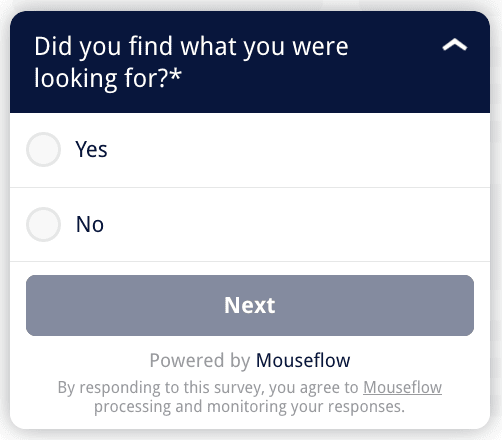
If they say no, ask a “What did you expect to find?” and make it an open-ended question. This survey is very short, but very useful.
Prioritize Ethics
Always prioritize customer privacy and use the data they share with you in ethical ways.
This is especially true when collecting feedback. After all, your customers don’t have to complete your surveys or attend interviews. They do it because they appreciate your brand.
Don’t reward their generosity by playing loose and fast with their personal details. Instead, develop a secure user feedback process so customers feel safe.
In addition, try to use customer feedback tools that are privacy-focused by default. Mouseflow, for example, automatically anonymizes user data. It doesn’t allow brands to record IP addresses either, as this is considered personally identifiable information.
How to Analyze and Utilize User Feedback
Let’s jump forward a bit …
You’ve sent your target audience a customer effort score (CES) survey to help evaluate your products. Or interviewed a top customer about their experience with your brand. Or added heatmap software to your website. You have access to a ton of data. What do you do with it?
First, understand the difference between quantitative feedback and qualitative feedback:
- Quantitative feedback: User feedback that can be measured with specific metrics. If you ask your customers, “Do you agree that the company made it easy for me to solve my problem?” then give them multiple ways to answer the question, you’re seeking quantitative user feedback.This kind of feedback will give you a baseline, by which you can evaluate your customer satisfaction metrics over time.
- Qualitative feedback: User feedback that can’t be measured with specific metrics. It’s based on individual opinions regarding customer satisfaction. If you ask your customers, “What can the company do to improve your website experience?” then give them an empty box to type their thoughts, you’re seeking qualitative user feedback.This kind of feedback will give you insights about what exactly to optimize and how.
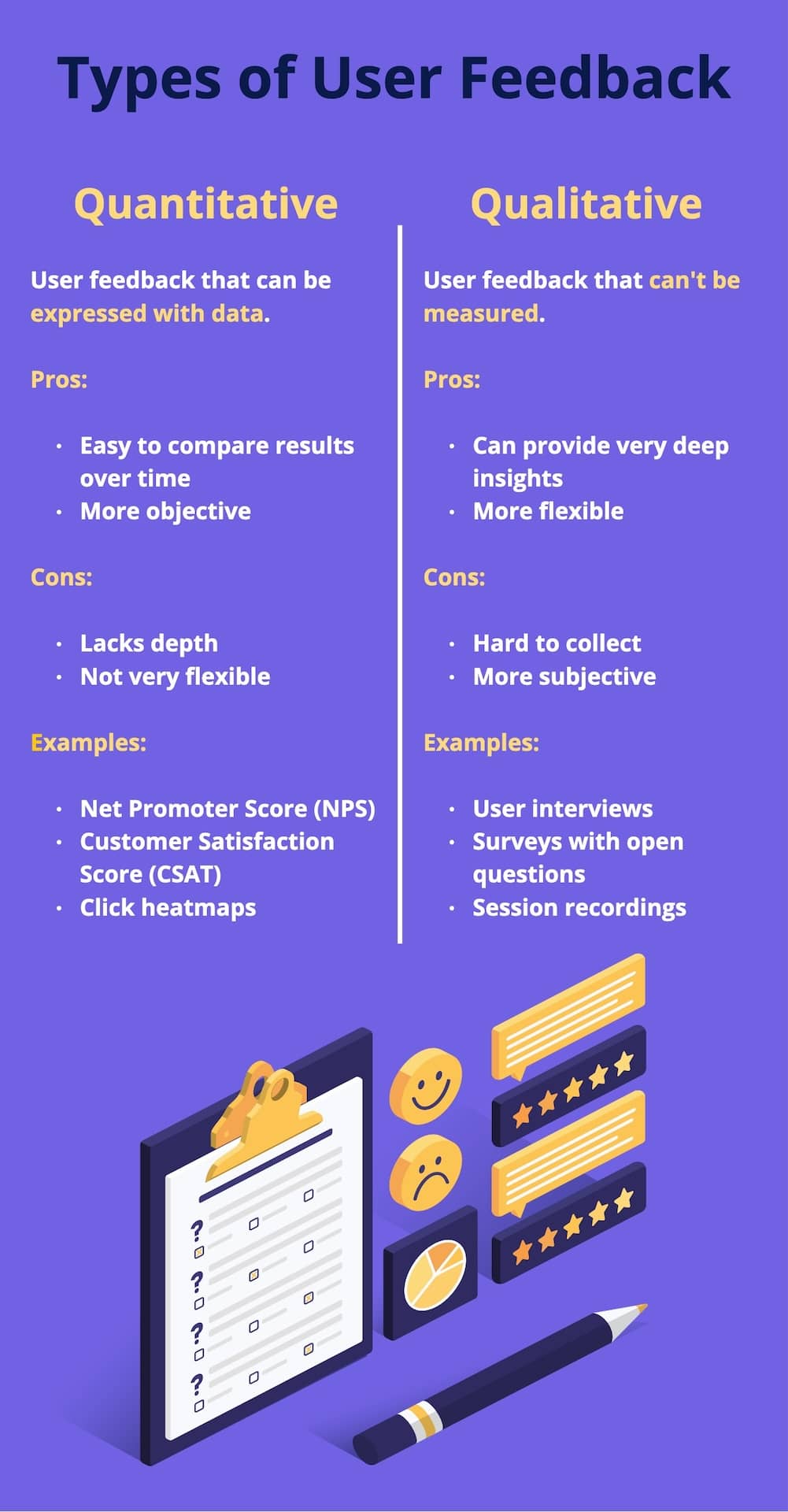
Both quantitative and qualitative insights are important. Your customer feedback efforts should try to capture both. But the question remains: what do you do with this data once you have it?
Take all of the information at your disposal — negative feedback, neutral feedback, and positive feedback — and study it. Look for patterns and trends. Then use what you learn to improve your product or service, build better marketing campaigns, supercharge customer loyalty, etc.
Difficulties of Collecting and Analyzing Customer Feedback
Gathering feedback is essential to the future success of your company. But it’s not always easy to do. While every organization is different, most will encounter three common challenges:
😩Data Overload
An avalanche of data is within your grasp. Once you start collecting feedback, you’ll become inundated with customer opinions — both good and bad.
It can be difficult to decide which data points to focus on. Fortunately, some tools use AI technology to analyze the sentiment behind customer comments. These solutions will help you understand the heart of your customers and improve their experiences.
Other tools, such as the survey replays and heatmaps inside Mouseflow, will pinpoint areas of friction for you, so you know exactly which aspects of your website to improve.
😩Channel Overload
You can collect feedback from a variety of sources — a customer survey, social media platforms, user behavior on your company’s website, etc.
To choose the right channels for your company and avoid overwhelm, ask yourself, “Which channels does my target audience use?” Then concentrate on those specific platforms.
Also, AI can convert one type of user feedback to another. For example, text-based conversations on social media platforms or customer support emails can be analyzed, then used to estimate the results of a potential customer satisfaction score (CSAT) survey.
😩Personal Biases
Finally, you might assume certain things about your products and/or audience that aren’t true.
These biases can be difficult to overcome. But if you continue to paint a false picture for yourself, you won’t be able to grow your company effectively.
Approach negative feedback with an open mind, and don’t let positive feedback make you overconfident. Leave your assumptions at the door, evaluate your data, and act accordingly.
Improve Your Business With User Feedback
User feedback will help you understand your target audience, improve your product or service, and ultimately, drive more revenue for your company.
You just need to decide which types of customer feedback you’ll collect, why you want to collect them, and the user feedback tool you’ll use to do the job.


